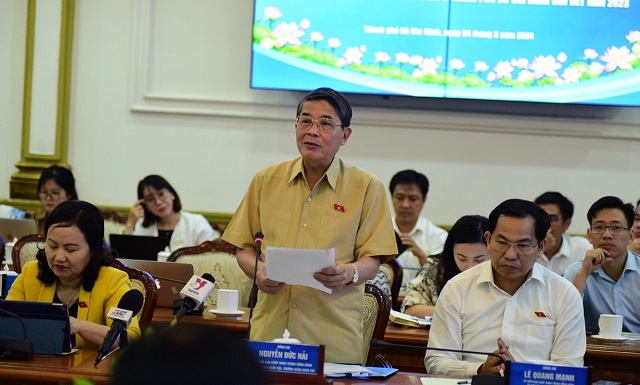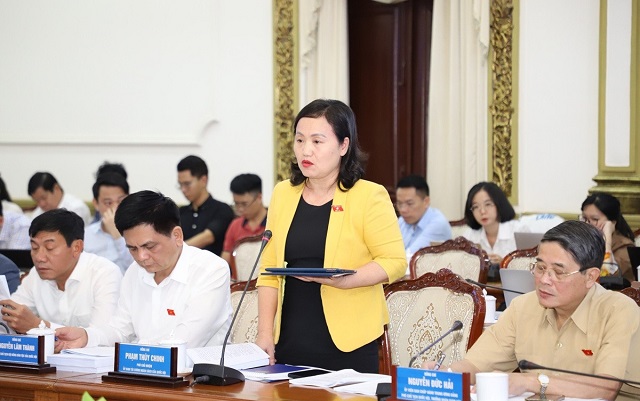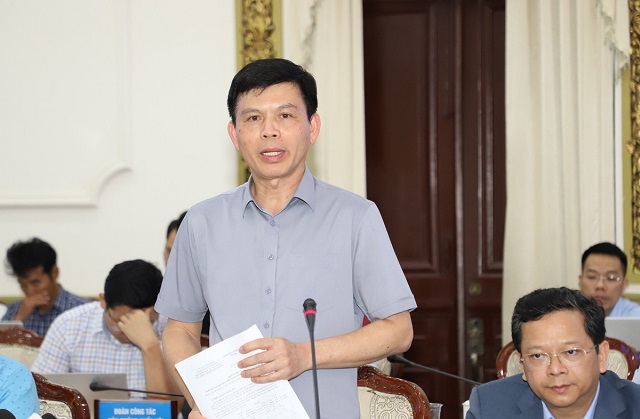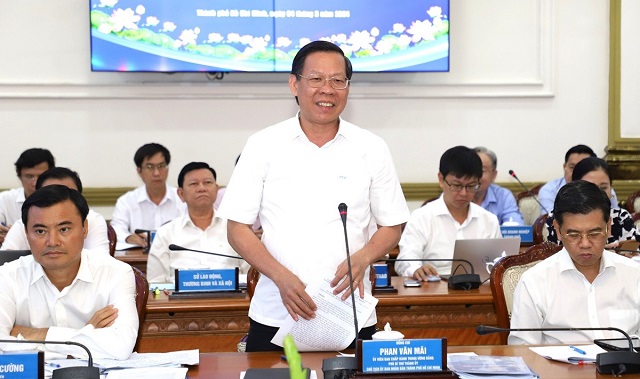On the afternoon of March 4, the National Assembly’s Supervisory Delegation led by Deputy Chairman of the National Assembly Nguyen Duc Hai had a working session with the Ho Chi Minh City People’s Committee on the implementation of Resolution 43 of the National Assembly on fiscal and monetary policies to support the program for economic and social recovery and Resolution 57 on the investment policy of Belt Road 3 project.
Also attending the working session were representatives from the People’s Committee of the provinces of Binh Duong, Dong Nai, and Long An.
 The National Assembly’s Supervisory Delegation working with the Ho Chi Minh City People’s Committee.
|
In his speech at the working session, Mrs. Pham Thi Kim Chi, Deputy Head of the Finance Committee of the National Assembly, highly appreciated the progress of the Belt Road 3 project.
“I see that the city places people at the center, listens to and takes into account the opinions of the people… Before setting the compensation prices for land clearance, a high level of consensus was reached, and the project progress has been accelerated,” Mrs. Chi expressed.
However, according to Mrs. Chi, some localities such as Dong Nai and Binh Duong are still behind schedule in some components. Therefore, as the leader, Ho Chi Minh City must support these localities to the fullest extent.

Deputy Head of the Finance Committee of the National Assembly Pham Thi Kim Chi speaking at the working session.
|
Some other delegates suggested that Ho Chi Minh City needs to demonstrate more clearly its role as the leader to achieve synchronization for the entire project. Representative Le Van Manh, in particular, assessed that Resolution on the Belt Road 3 project allows for the designation of certain bidding packages, which has shortened the time and accelerated the progress.
“Therefore, the mechanism of designating bids has significantly shortened the time. We want to hear more about this issue to learn lessons for future projects,” Mr. Manh proposed.
In conclusion, Deputy Chairman of the National Assembly Nguyen Duc Hai stated that the Supervisory Delegation highly appreciates the achievements of Ho Chi Minh City in implementing Resolution 43 and Resolution 57, overcoming difficulties, gradually recovering and developing the economy and society, and stabilizing people’s lives. Specifically, the GRDP in 2022 increased by 9.03%, and in 2023 it increased by 5.81%. The implementation of Belt Road 3 is also determined to closely follow the schedule.

Deputy Chairman of the National Assembly Nguyen Duc Hai concluding the working session.
|
However, according to Mr. Nguyen Duc Hai, the Belt Road 3 project still has some components that have not met the schedule. Specifically, the process of establishment, appraisal, and approval of technical designs and estimates for component projects under the management authority of the provinces of Dong Nai and Binh Duong is still slow.
The repair and maintenance of technical infrastructure related to resettlement areas are slow. There are lawsuits regarding the compensation rates for agricultural land in cases where there is both residential and agricultural land. The preparation and allocation of land and resettlement apartments for residents in some places have not been timely.
In terms of material supply, especially sand, Deputy Chairman of the National Assembly expressed concern about the risk of shortage due to the suspension of some mining activities, while many expressways are being developed at the same time.
Based on the above issues, Mr. Nguyen Duc Hai suggested that Ho Chi Minh City and relevant localities continue to supplement and evaluate the effectiveness of coordination among localities; determine compensation rates, support, and specific responsibilities of relevant agencies, organizations, and individuals, as well as make specific proposals and solutions to complete land recovery and resettlement support.
At the same time, he suggested further evaluation of the causes and responsibilities, effectiveness of the allocation of capital for the project that has resulted in the unused compensation fund originally allocated for the project and the large remaining fund; report more clearly and propose specific solutions to ensure the supply of building materials, especially sand and fill soil.
Special mechanisms to accelerate the Belt Road 3 project
Prior to that, in the explanation to the Supervisory Delegation, Deputy Minister of Transport Le Anh Tuan affirmed that the progress of the Belt Road 3 project has been accelerated thanks to 3 special mechanisms in Resolution 57.

Deputy Minister of Transport Le Anh Tuan explaining at the working session.
|
Firstly, the capital for the project is shared between local and central authorities. According to Mr. Tuan, at the time of project initiation, the Ministry of Transport had only about 17 trillion VND and did not know how to proceed. The capital mechanism has resolved the obstacles for the project.
Secondly, land clearance work is separated into a separate project.
Thirdly, the mechanism shortens procedures and exploits materials. If following the previous procedure, searching for materials, approving, and then extracting would take a long time. Currently, the provinces in the Mekong Delta have committed to supply materials for the project, thereby ensuring the progress of the project.

Chairman of the Ho Chi Minh City People’s Committee Phan Van Mai expressing opinions at the working session.
|
Phan Van Mai, Chairman of the Ho Chi Minh City People’s Committee, also stated that Resolution 57 with these special mechanisms has helped accelerate the progress of the Belt Road 3 project. Specifically, in June 2022, the National Assembly issued the resolution, and by the end of 2023, the appearance of the road was visible, despite the project requiring a capital of over 70 trillion VND, which is not easy to implement.
“This is a lesson for Ho Chi Minh City to apply to the construction of Belt Road 4 and other developing expressway projects. In particular, the city will approach the 200km railway construction project based on the experience of implementing Belt Road 3,” Mr. Phan Van Mai said.
Ho Van









































